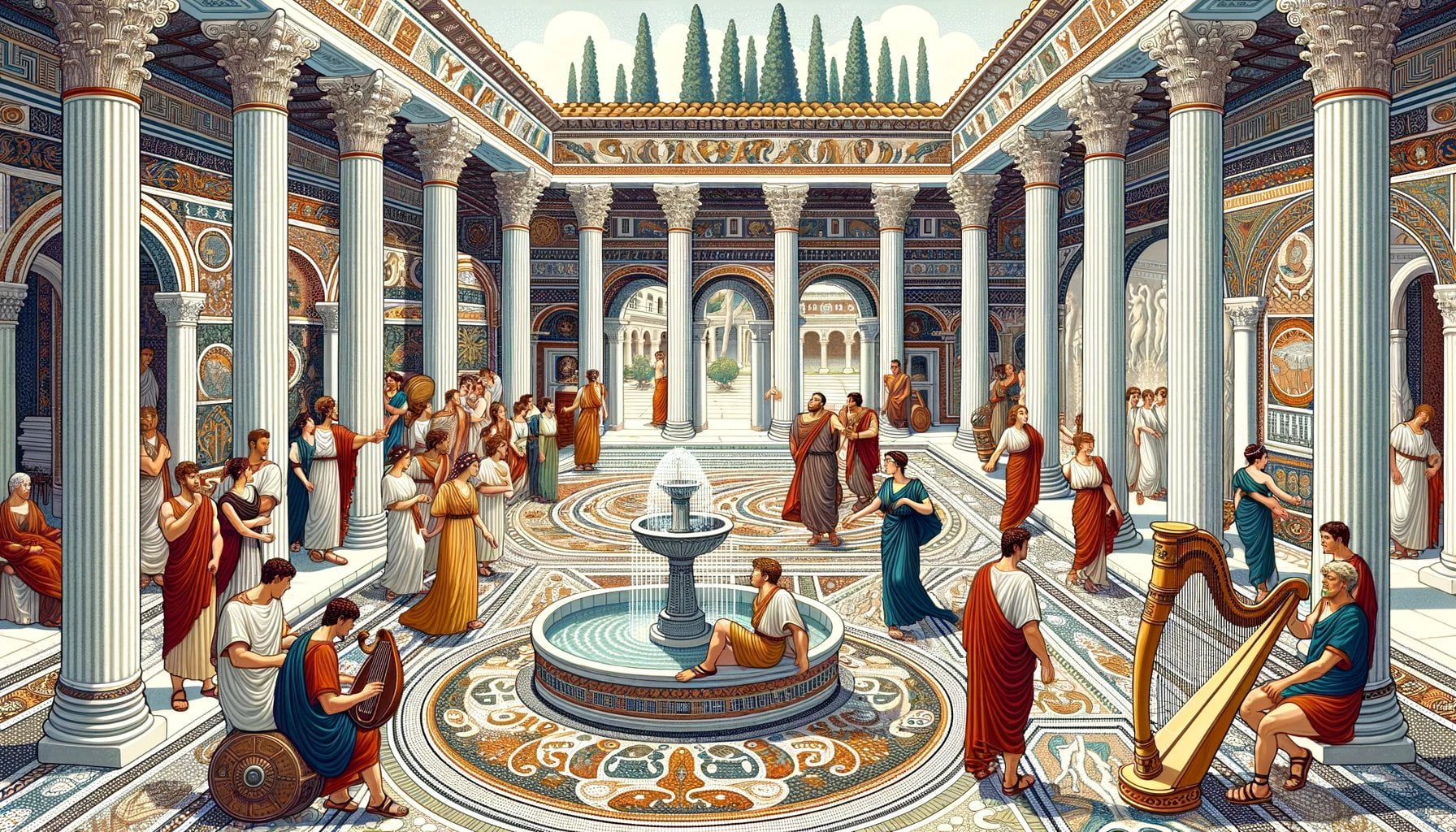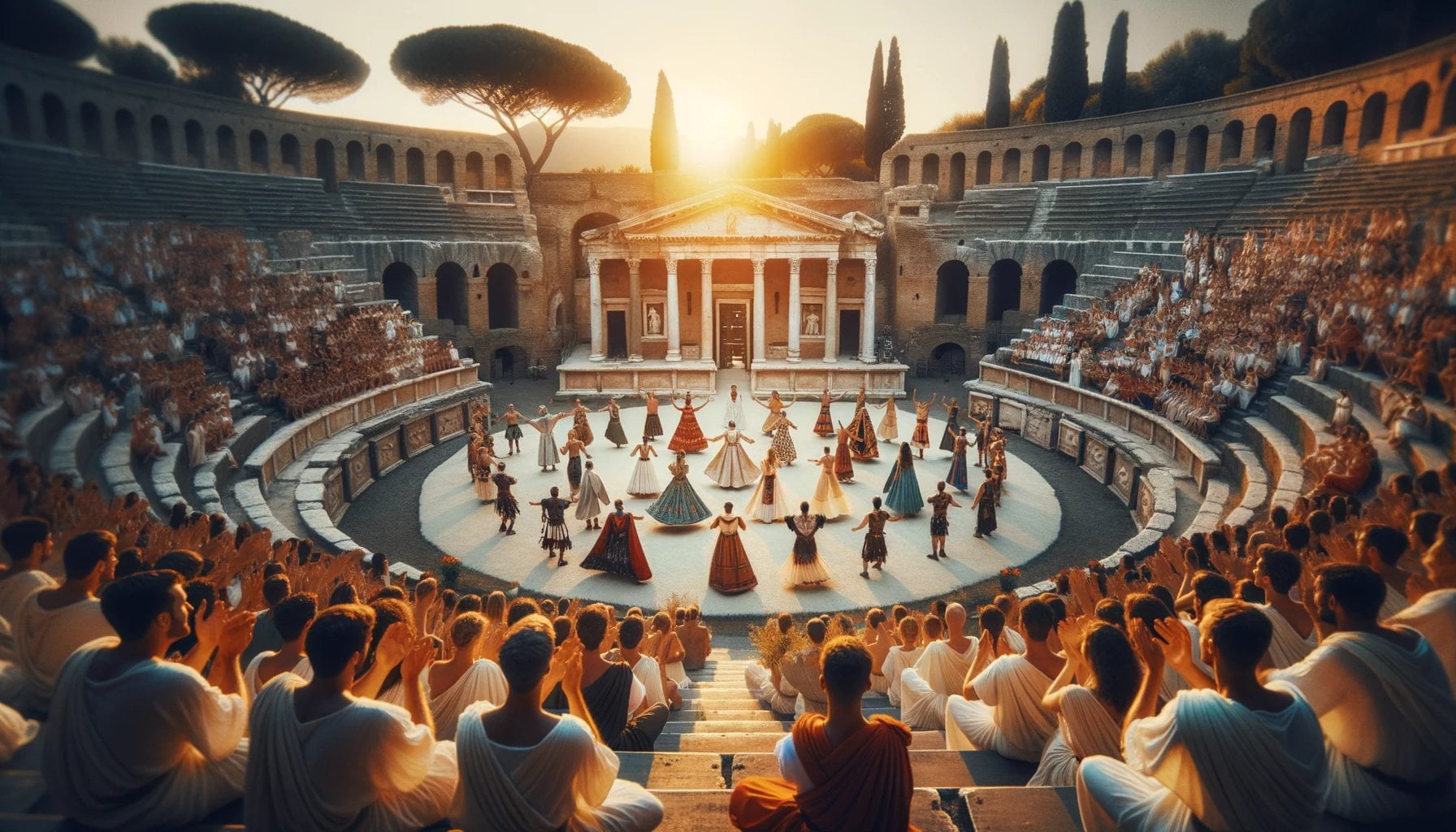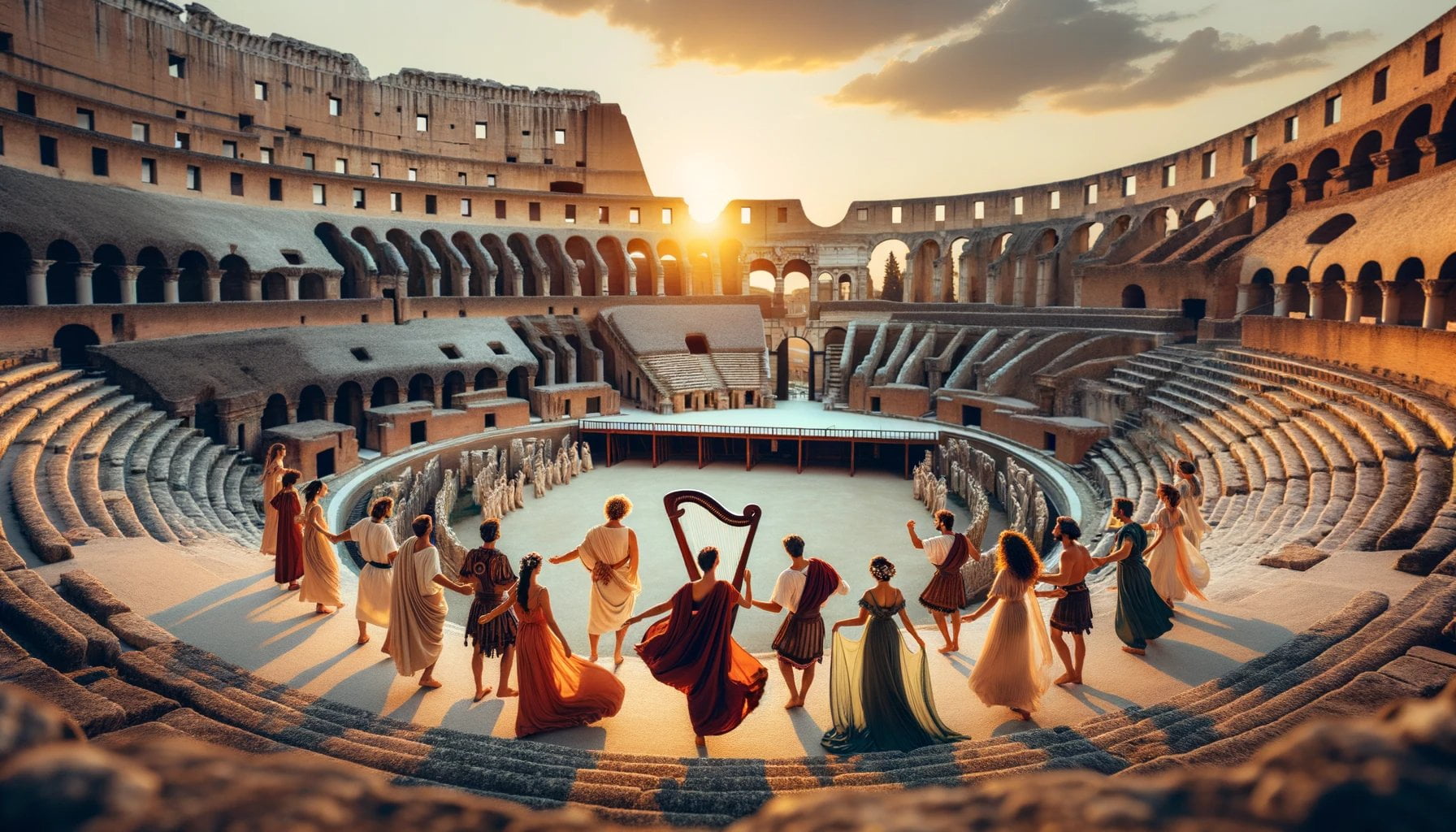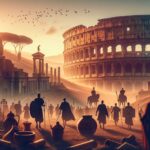Unveiling the Mesmerizing Dance Culture of Ancient Rome takes us on a journey to explore the captivating realm of ancient Roman dance. Steeped in rich historical context and enigmatic movements, this article will delve into the intricate dance forms that flourished in the heart of the Roman Empire. From expressive gestures that mirrored daily life to elaborate performances that dazzled spectators, the dance culture of ancient Rome offers a mesmerizing glimpse into the vibrant tapestry of this iconic civilization. Join us as we uncover the spellbinding stories etched within the rhythms of ancient Rome.

Key Takeaways:
- Ancient Roman dance was diverse and played a significant role in their culture.
- Bacchanal dance was a popular and energetic form of dance associated with festivals and celebrations.
- Tragic dance was a solemn and mournful form of dance performed during funeral rites and events related to death.
- Cordax dance was a playful and joyful dance associated with comedy, often performed during theatrical plays.
- Pantomimes were dramatic performances that involved miming roles and were highly entertaining.
- Etruscan culture influenced the development of Roman dance.
- Instruments like the lyre, flute, trumpet, and tambourine were commonly used in ancient Roman dances.
- Ancient Roman dancers wore costumes appropriate for each dance style and occasion.
- Dancers were trained in specialized schools or mentored by experienced individuals.
- Ancient Roman dance served as entertainment, religious expression, and artistic storytelling, connecting the Romans with their traditions, talent, and deities.
Ancient Roman Dance: Exploring the Art and Entertainment of the Romans
Types of Dances
- Bacchanal Dance: Bacchanal dance was a vibrant and lively form of dance that was closely associated with the god Bacchus. It was commonly performed during festivals and celebrations, adding an element of joy and energy to these events.
- Tragic Dance: Tragic dance, as the name suggests, was characterized by solemn and mournful movements. It was often performed during funeral rites or events that revolved around death and tragedy. This dance form helped the Romans express their emotions and pay tribute to their departed loved ones.
- Cordax Dance: The Cordax dance brought laughter and amusement to the Romans. It was associated with comedy and involved playful and joyful movements. Typically performed during theatrical plays and comedic events, this dance form showcased the Romans’ lighthearted side.
- Pantomimes: Pantomimes were captivating performances that combined mime, dance, and music. Similar to modern ballet, they incorporated visual effects and drew inspiration from Greek mythology. Pantomimes were immensely popular among the Romans, providing them with a visual spectacle and a way to immerse themselves in ancient stories.
Influence of Etruria
The Romans were greatly influenced by the Etruscans when it came to dance. The Etruscans introduced various dance forms to the Romans, contributing to the development and richness of their dance culture. These influences from Etruria played a significant role in shaping the dances performed in ancient Rome.
Instruments and Music
Music was an essential component of ancient Roman dances, setting the rhythm and creating a melodic atmosphere. The Romans utilized instruments such as the lyre, flute, trumpet, and tambourine to accompany the dancers. These instruments added an enchanting aura to the performances, enhancing the overall experience for both the dancers and the audience.
Costumes and Attire
The costumes worn by ancient Roman dancers varied depending on the type of dance and the occasion. Elaborate dresses, tunics, and other attire were carefully chosen to match the dance style and the character being portrayed. The costumes not only enhanced the visual aesthetics of the performances but also helped convey the story and emotions behind each dance.
Learning and Training
Ancient Roman dancers underwent specialized training to master their art. They received instruction in dance schools or from experienced mentors who passed on their knowledge and techniques. Rigorous practice sessions and a deep understanding of the cultural significance behind each dance form were integral parts of the training process. Through this training, the dancers honed their skills and brought the dances to life with finesse and precision.
In conclusion, ancient Roman dance was a captivating art form that held deep cultural significance for the Romans. The different types of dances, influenced by both Greek and Etruscan cultures, allowed the Romans to express their emotions, celebrate their traditions, and connect with their gods and ancestors. Whether it was the lively Bacchanal dance, the mournful Tragic dance, the joyful Cordax dance, or the enchanting pantomimes, dance played an integral role in the art and entertainment of ancient Rome.
Sources:
- Encyclopedia.com – “Dance in Rome”
- Ancient-Rome.info – “Types of Dances in Ancient Rome”
In ancient Rome, poetry played a significant role in shaping the culture and expressing emotions. Discover the rich world of poetry in ancient Rome by delving into the captivating works of renowned poets. Learn more about poetry in ancient Rome here: poetry in ancient Rome.
Ancient Rome was dotted with charming villages that thrived in their own unique ways. Explore the enchanting tales and history of these ancient Roman villages, where traditions and community thrived. Immerse yourself in the allure of villages in ancient Rome by clicking here: villages in ancient Rome.
Games were a beloved pastime in ancient Rome, offering entertainment and excitement for both spectators and participants. Delve into the thrilling world of ancient Roman games, where skill and strategy were put to the test. Uncover the secrets of games in ancient Rome by clicking here: games in ancient Rome.
Ancient Rome faced various invasions from ruthless conquerors, leaving a lasting impact on the empire’s history. Discover the stories and struggles of these invaders who challenged the mighty Roman Empire. Unravel the tales of invaders of ancient Rome by clicking here: invaders of ancient Rome.
The role of a praetor in ancient Rome was vital in maintaining order and delivering justice. Delve into the responsibilities and power associated with this prestigious position, where decisions shaped the fate of many. Learn more about the praetors of ancient Rome and their significant role by clicking here: praetor ancient Rome.
Ancient battles in Rome were epic clashes of power, where nations fought fiercely for dominance and survival. Step into the battlegrounds of ancient Rome and witness the courage and sacrifice of warriors who left their mark in history. Experience ancient battle of Rome by clicking here: ancient battle Rome.
Importance of Dance in Roman Society
Dance in ancient Rome held a complex and sometimes contradictory place in society. While it played a less prominent role compared to Greek culture, dance was still an integral part of Roman festivals and religious ceremonies. However, the Roman nobility viewed dancers with suspicion, considering them effeminate and even dangerous[^1^][^2^]. Despite these negative perceptions, the significance of dance in Roman society cannot be overlooked.
Key Takeaways:
– Dance was less prominent in Roman culture compared to Greek culture, but it still had cultural significance.
– Most types of dancing in Rome were imported from Greece, showcasing the influence of Greek culture on Roman society.
– Dancing played an important role in Roman festivals and religious ceremonies.
– The Roman nobility held negative views towards dancers, perceiving them as effeminate and dangerous.
The celebrations of Lupercalia and Saturnalia featured wild group dances that resembled later European carnivals[^1^]. As Greek and Etruscan influences began to spread, dancing became more prevalent in Rome. The Etruscans greatly influenced Roman dance, introducing various dance forms and shaping the dances performed in ancient Rome[^2^].
Instruments such as the lyre, flute, trumpet, and tambourine accompanied the dancers, adding to the overall experience. These musical elements added rhythm and enhanced the emotional impact of the dances[^1^].
Dance in ancient Rome was not only a form of entertainment but also a means of expression. Dancers conveyed emotions, celebrated traditions, and connected with gods and ancestors[^1^][^2^]. Each dance style had its own story and conveyed different emotions, with costumes carefully chosen to match the dance and its intended message.
While ancient Roman dancers did not receive the same level of esteem as their Greek counterparts, they still underwent specialized training. Some dancers attended dance schools, while others learned from experienced mentors[^2^].
Understanding the importance of dance in Roman society helps shed light on the cultural fabric of ancient Rome. Despite the reservations of the Roman nobility, dance played a significant role in both religious and social contexts, enriching the lives of the Roman people.
Sources:
- Ancient Greece and Rome: An Encyclopedia for Students – erenow.net
- Ancient Roman Dance and Music – ancient-rome.info
Dancers and Performances in Ancient Rome
Ancient Rome, a civilization known for its grandeur and influence, boasted a mesmerizing dance culture that played a significant role in its society. Let’s delve into the captivating world of Roman dance, exploring its historical context, various dance forms, and the significance it held in that era.
Ancient Roman dances were not merely figments of imagination; they were described in recovered texts and depicted in Roman art, giving us invaluable insights into this form of expression [^1^]. These dances were primarily performed for religious and ceremonial purposes, elevating them to a sacred realm [^2^].
Two prominent types of Roman dances were the Cordax and the Pantomimes [^3^]. The Cordax was a comedic dance that brought laughter and amusement to the audience, often associated with theatrical plays [^4^]. On the other hand, the Pantomimes involved miming roles accompanied by singers, dancers, and musicians, providing a visual spectacle inspired by Greek mythology [^4^].
It’s fascinating to note that some Roman dances had origins in Etruscan and other national dances of the country, showcasing the influence of neighboring cultures on ancient Roman movement [^5^]. Initially, dancing and music in Rome were performed exclusively during religious occasions, demonstrating their close connection with spirituality [^6^].
Music played a pivotal role in Roman religious rituals, setting the rhythm and invoking specific emotions [^7^]. Instruments like the lyre, flute, trumpet, and tambourine enhanced the overall experience, creating an immersive atmosphere that transported the audience to another realm [^8^].
However, despite their artistic prowess, Roman dancers occupied a societal position with low social status [^8^]. In comparison to Greece, Roman dances were not as highly regarded as a form of entertainment [^9^]. Nevertheless, dancing and singing to music in ancient Rome served as a common leisure activity, letting individuals express themselves and find joy in movement [^10^].
As we immerse ourselves in the rich tapestry of ancient Roman dance, it becomes evident that this art form was far more than just entertainment. It held a deep cultural significance, intertwining spirituality, storytelling, and celebration. By unraveling the mysteries of Roman dance, we gain a nuanced understanding of this mesmerizing world and its enduring impact on history.
Key Takeaways:
- Ancient Roman dances were described in recovered texts and depicted in Roman art [^1^].
- These dances were mainly performed for religious and ceremonial purposes [^2^].
- The Cordax and the Pantomimes were two prominent types of Roman dances [^3^].
- The Cordax was a comedic dance associated with theatrical plays, while the Pantomimes involved miming roles accompanied by singers, dancers, and musicians [^4^].
- Some Roman dances drew inspiration from Etruscan and other national dances [^5^].
- Initially, dancing and music in Rome were performed exclusively on religious occasions [^6^].
- Music played a crucial role in Roman religious rituals, setting the rhythm and invoking specific emotions [^7^].
- Roman dancers held low social status, and Roman dances were not as highly regarded as in Greece [^8^][^9^].
- However, dancing and singing to music in ancient Rome were common forms of leisure activity [^10^].
Citations:
– Savvy Leo Education Site. “Ancient Roman Dance.” Savvy Leo. source
– Ancient-Rome.info. “Ancient Roman Dances.” Ancient-Rome.info. source
Legacy and Influence of Ancient Roman Dance
Ancient Rome, with its rich cultural heritage, witnessed the birth and evolution of various art forms, including dance. The dance culture of ancient Rome was deeply influenced by the styles of Etruscan and Greek dance, and it left a lasting legacy on Roman culture and society. In this article, we will delve into the legacy and influence of ancient Roman dance, exploring its historical context, various dance forms, and its significance in Roman society. Join me on this captivating journey as we uncover the mesmerizing world of ancient Roman dance.
Influence of Greek and Etruscan Dance
The influence of Greek dance on ancient Roman dance cannot be overstated. Greek dancers introduced Pyrrhic dances, which had a significant impact on Roman dance. These dances were characterized by their martial movements and were widely embraced by the Romans. Additionally, Greek slaves with knowledge of dance were brought to Rome to display their skills for entertainment purposes, further contributing to the influence of Greek dance on Roman culture.
The Etruscans also played a crucial role in shaping Roman dance. Many religious dance forms in Rome originated from Etruscan traditions. Roman dance was initially performed exclusively on religious occasions, and it drew inspiration from the Etruscan dance forms. As Roman society evolved, dance gradually found its way into theaters, where famous ancient dancers like Bathyllus and Pylades performed, adding a new dimension to the dance culture.
Incorporation into Public Entertainment
Ancient Roman dance had a profound impact on Roman culture and was eventually incorporated into public entertainment. It became an integral part of Roman festivals and religious ceremonies. The legacy of Roman dance can be seen in its incorporation into theatrical plays and its influence on other art forms. Dance became a means of expression, allowing Roman dancers to convey emotions, celebrate traditions, and connect with gods and ancestors.
Cultural Significance and Legacy
Despite dance in ancient Rome playing a less prominent role compared to Greek culture, it had a significant cultural influence. Roman dance was a form of entertainment that captured the attention and imagination of the populace. Various dance styles, such as the lively Bacchanal dance associated with Bacchus and the solemn Tragic dance performed during funeral rites, showcased the diversity and emotional range of Roman dance.
The legacy of ancient Roman dance can be seen in its depiction in recovered texts and Roman art. These artifacts provide glimpses into the dance forms and costumes that were prevalent in ancient Rome. The Roman nobility may have viewed dancers with suspicion, considering them effeminate and dangerous, but dance continued to flourish as an art form cherished by the masses.
In conclusion, the legacy and influence of ancient Roman dance are undeniable. From its roots in Etruscan and Greek dance to its incorporation into public entertainment and its cultural significance, Roman dance remains an intriguing and captivating art form. By exploring its historical context, various dance forms, and its significance in Roman society, we gain a nuanced understanding of the mesmerizing world of ancient Roman dance.
Key Takeaways:
– Ancient Roman dance was influenced by Greek and Etruscan dance styles.
– It gradually became introduced in theaters and public entertainment.
– Roman dance played a significant role in expressing emotions, celebrating traditions, and connecting with gods and ancestors.
– The influence of Roman dance can be seen in its incorporation into theatrical plays and its depiction in recovered texts and Roman art.

FAQ
Q1: What types of dances were popular in ancient Rome?
A1: Popular dances in ancient Rome included Bacchanal dance, Tragic dance, Cordax dance, and Pantomimes.
Q2: What were the influences on ancient Roman dance?
A2: Ancient Roman dance was influenced by Etruscan and Greek dance styles. Greek slaves who knew how to dance were made to display their skills in Rome for entertainment purposes.
Q3: What role did music play in ancient Roman dances?
A3: Music played a crucial role in ancient Roman dances. Instruments like the lyre, flute, trumpet, and tambourine were commonly used to create rhythmic and melodic accompaniments for the dancers.
Q4: How were ancient Roman dancers trained?
A4: Ancient Roman dancers received specialized training either in dance schools or by experienced mentors. They underwent rigorous practice sessions and learned the specific skills and techniques required for each dance style.
Q5: How were ancient Roman dancers perceived in society?
A5: Ancient Roman dancers were considered professionals but held low social status. They were not as highly regarded as a form of entertainment compared to Greece.
- Crypto Quotes’ Red Flags: Avoid Costly Mistakes - June 30, 2025
- Unlock Inspirational Crypto Quotes: Future Predictions - June 30, 2025
- Famous Bitcoin Quotes: A Deep Dive into Crypto’s History - June 30, 2025
















